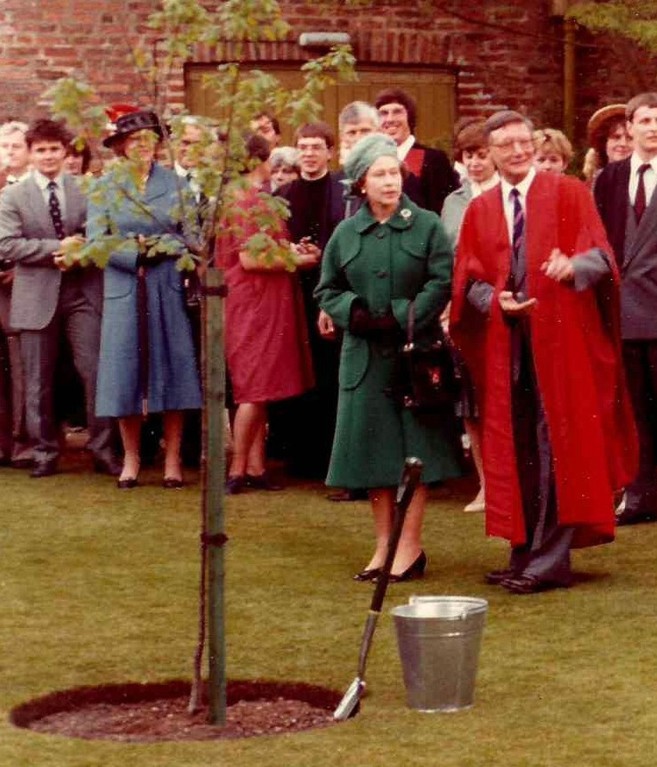Blog
2 October 2025
Q is for… Quatercentenary, Queen Elizabeth II & Quercus robur

A college event combining three Qs may sound unlikely, but such a confluence occurred on 16 May 1984. On that memorable occasion, Queen Elizabeth II, accompanied by Prince Philip, then Chancellor of Cambridge University, visited Emmanuel to mark the 400th anniversary, or quatercentenary, of its founding. As well as touring the older parts of the college, Queen Elizabeth planted an English oak (Quercus robur), that has since grown into what might fittingly be described as a majestic tree. A member of the royal entourage confided to one of the college Fellows that the Queen was unwell, and that anyone else would have cancelled the engagement. The sovereign nevertheless snapped to attention when shown one of the treasures of Emmanuel’s library, a prayer book almost certainly once owned by Arthur, Prince of Wales, Henry VIII’s short-lived older brother. Confronted with its copious Tudor heraldic illumination, including the ‘three feathers’ badge of the princes of Wales, her late Majesty immediately asked: ‘How did this get here?’ (it must have been a gift from the college’s Founder, Sir Walter Mildmay, but how he acquired it is unknown). Queen Elizabeth’s visit was the highlight of Emmanuel’s quatercentenary celebrations, but there were many other festivities, including a garden party. A special exhibition was put on at the Fitzwilliam Museum, displaying the most prized items from Emmanuel’s collections of archives, manuscripts, books, plate and pictures. Selecting a definitive date for the foundation of our college is impossible. For one thing, the process involved a series of preliminary property transfers, commencing in 1583. For another, there were not one, but two, principal foundation instruments. These were the charters granted by Elizabeth I and Sir Walter Mildmay, dated 11 January and 25 May 1584, respectively. The college was not ready to admit students, though, until November of that year.
Q is for…Query Club
Since the formation of the Emmanuel Boat Club in 1827, a good many student clubs and societies have flourished here. Some are still going strong, while others dissolved after a decent innings. Quite a number lasted only a few years, leaving little or no documentation. They included the Nightwatchmen (purpose uncertain), the Sauceboat Club (fine dining), the Hort Society (Catholicism), the Scramblers (breakfast club) and the Lay Brothers (evensong, mead-drinking and picnics in punts!). A short-lived Edwardian society was the Query Club, that existed for only two years and soon passed from collegiate memory. Fortunately, its solitary minute book came to light decades later. The club was established in February 1910, its object being ‘the discussion of social, political, & religious problems’. Presumably, the adversarial format of the college Debating Society did not appeal to the Query Club’s members. They were an enthusiastic bunch, whose discussions were impressively wide-ranging and covered many topics that are still relevant today. Predictably, choosing the design of the termly meeting cards generated a prolonged discussion in itself, but eventually members settled on the logo shown above. Fans of the ‘Three Investigators’ juvenile detective books will be amused to know that a motif comprising three question marks in a row was always printed inside the cards. In common with so many of the college’s short-lived student societies, the Query Club did not survive the departure from Emmanuel of its founding members. Joshua Burn, one of the principal instigators, took the club’s minute book with him when he graduated in 1912, carefully preserving it until his death in 1981. This slim volume shows that the Query Club provided its members with, above all else, a huge amount of fun – and that was more than enough to justify its brief existence.
Amanda Goode, College Archivist
.JPG)